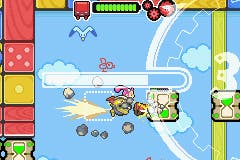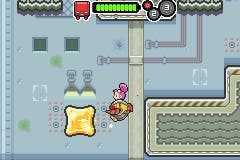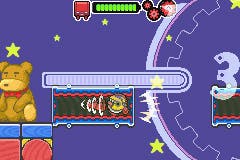Drill Dozer
Dozer good job.
A good platform game's a bit like a clever detective. Probably one with a decent catchphrase and a bumbling sidekick he has to explain everything to. He's got his facts, and he's got you in the interrogation room. But you're a master crim! Artfully deflecting his aggression and smugly evading his traps of logic. Eventually one of you will win, but in the meantime there's room for lots of brinkmanship, you've got his magnificent trademark coat to admire - and what with Sherlock Holmes, Diagnosis Murder and that Gene Wilder one I saw at Christmas eating up all the good outfits and particularly hats, chances are it'll be a smoking jacket or a ballerina outfit.
But of course not all platform games are like this. Some of them wear you down by sitting and asking the same question over and over, while others go completely the other way and just keep changing subject so much that you quickly forget who you are, what you're doing and which buttons to push while you're being tripped up. Others just storm up to you like Jack Bauer, shoot you in the kneecap and bellow things like WHERE ARE THE CHAOS EMERALDS.
Drill Dozer, cobbled together by Pokemon developer Game Freak, is very much the clever detective, starting with a simple theme and gradually expanding upon it without ever abandoning the core idea. Thrust into a drill dozer suit, you're hot on the trail of some chaps who pinched your red diamond, and you're going to recover it by working your way through 2D side-scrolling platform levels that rely on your spinning drill-bit to break through walls and blocks, skip across pits, reach higher areas and unravel a clever group of enemies. It's all about drilling. You jump, you can drill clockwise or anti-clockwise by tugging L or R, and you can upgrade your bit twice per level to increase the drill action's speed and longevity. And while the questions the game asks grow ever more elaborate, they always focus on the key facts - and you're the one in the magnificent outfit.

Early on, you discover that when a breakable block is perched on the edge of a ledge you want to reach, you can leap toward it, drill through it and be deposited on the ledge in a single motion - rather than drilling, dropping down once it's broken through, as logic might dictate, and clambering back up again. This strikes you as a smart bit of design anyway, but then you realise that if a trio of blocks are suspended next to each other in the air, and your drill-bit is sufficiently upgraded (the third upgrade, or gear, allows you to drill indefinitely), you can drill them all in one chain and reach out of the way health pick-ups or collectible computer chips.
Soon you're faced with air-conditioning vents threaded as if for a screw - and you can haul yourself through these by drilling the correct way. A nice application of your skills, which soon demands concentration by chasing you with electric sparks, or having peculiar vent-poking crabs hack away at it, or having you move backward and forward in the vent to stay out of the way of the sparks and perilous dead-ends.
Instead of simply having moving platforms (though it does), Drill Dozer has moving sockets, which you lock into with your drill-bit - and remain attached to for as long as your drill spins. The simpler ones you attach to from the bottom; the harder ones are horizontal, and often involve switching sides with the left and right pad directions to avoid bumping into hard ledges and blocks. There's even a manner of wall-jumping. When locked into a socket, or with your drill bound to a wobbly jelly block, spinning up and then hitting the opposite spin direction propels you upward and backward; in some areas, you're asked to climb from jelly block to jelly block or socket to socket using this technique, and each upgrade allows you to leap a bit further.

Rarely is anything unintuitive. You might find the handholding you receive from your drilling pals to go a bit far to begin with, but they soon shut up and leave you to get on with things. And things are vibrantly coloured, traditionally 16-bit in style and animation, and accompanied by a marvellously bouncy soundtrack - not to mention the optional rumbling of the cartridge, the ferocity of which helps to demonstrate which drill-gear you're in. Well, I say ferocity; it's hardly Jack Bauer.
Each of the game's dozen or so stages is a handsome, varied and frequently surprising affair, mixing puzzles with platform tests and sprinkling the whole thing with combat. Enemies generally have to be drilled for a certain period of time - as they grow more battle-hardened, you'll have to try and get behind them to do this, or avoid invincible states and the like. Bosses, meanwhile, are a genuine pleasure - demanding nimble thumbs to dodge their projectiles and a bit of cunning to find their weak spots, all of which are literally undone, as you've guessed, by a good bit of drilling.

There's a lovely fluidity to the whole thing, too. As you smilingly out-manoeuvre your two-dimensional accuser, you're flung toward disparate objectives down seemingly maze-like branches, but always lead inexorably back to the point of convergence - back-tracking is seldom a problem, nor is the age-old platform peril of "saving that route for later" and then having access to it cut off forever 32 pixels down the road. What's more, anything you do miss can be returned to afterward - levels are scattered with blocks that you can't break through immediately, and so you spend the computer chips you've amassed at the shop to buy drill-bits that can do it, and subsequently return to track down their hidden treasure. It's not quite as satisfying as all that, but there are a handful of hidden expert levels to unlock this way, which is nice since the single-player game is relatively short - you won't complete it in the space of a lengthy commute, but you probably will within a week of them.
Should you decide to, you'll have a lovely time. Having to collect the second and third gears anew on each level can be a little annoying, but it's forgivable in light of the way they thread together - there's a feeling of respect for the player, and an understanding of how to reward, rather than the patronising inevitability of some recent platform games we could mention. And on every level there's some new challenge, like advanced drill-bits that change your method of movement (trying not to spoil it here), or a clever idea, like gradually drawing back a sequence of curtains to reveal enemy groups rather than just dropping them into your path like everyone else does. It's possible you'll tire of Drill Dozer's slightly repetitive drill cycle, and there's less room for exploration and investigation than you'll find in something like Super Mario World, but given it's 15 years and about 48 million 2D platform games later, it's nice to find a developer who can still offer a fresh line of questioning - and a nice suit to wear while doing it.

